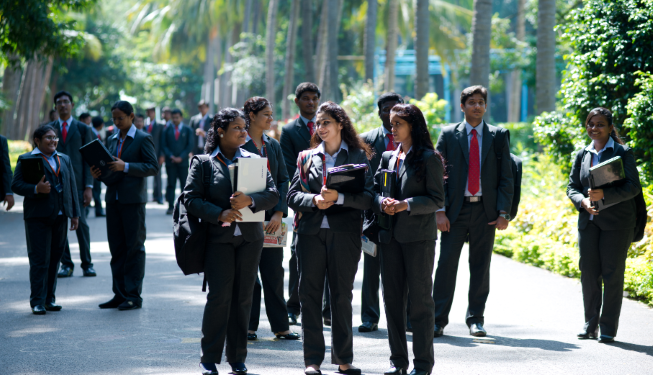According to Dr. V.P. Singh, Professor of Economics, Great Lakes Institute of Management, Gurgaon, one can’t expect much from the Union Budget for the higher education sector. It lacks financial muscle to make any significant change. Total receipts of the government, excluding borrowings, for 2022-23 is estimated to be around Rs 23 lakh crore and expenditure around Rs 39 lakh crore. Spending over 35 crore Indian households spreads it too thin. But, the government does have intent to make significant change. This adequately reflects through the policy changes and the rapid increases in number of seats for admission. The major spending has to come from the private sector and there is huge demand.
Good B-Schools generally receive not less than 5,000 applications against say 240 seats availability, implying a demand of more than 20 times the available supply. With such supply the higher education market is certainly a sellers’ market. Add to this the fact that last year 11 lakh Indian students travelled abroad for higher education. A rough estimate of the expenditure comes out to be Rs 3000 crores. Indian B-schools keep cribbing about the quality of students they get. Why don’t Indian B-Schools get these students? Are these students who travel abroad inferior? Should not be. Government has to increase the Gross Enrolment Ratio in higher education to 50% by 2035. That is why it is giving approvals of higher intake in both offline as well as online courses. Are Indian institutions ready to absorb this demand? Government does not feel so and that’s why it is letting foreign universities open their centres in India. Instead of waiting for the government -scale digitization, invest in teachers training and encourage foreign collaborations, he added.
Sanjay Viswanathan, Chairman AdiGroup and Ed4All provides a formula how to innovatively secure Rs 80 lakh crore to ensure Education and Skilling is well funded. In his words:“Budget 2023-24 must address twin subjects of Education and Skills that are presently under-invested and underwhelming. India needs to keep aside at least 4% of its Budget for this, and for the next 25 years.
Two logical sources of financing must be tapped. First is external financing through Institutional Investors – SWF and PF – to invest through long-term, low-cost capital. Position Education similar to Infrastructure and incentivise investors through a framework of structures (SPV) with sovereign guarantees. India can secure circa $500bn of infrastructure-orientated capital over 25 years with this.
Second, internal financing. Establish 10yr Education and Skills Tax (EST) aimed at every firm in India, public and private, that generate revenues of Rs 10 crore and above to pay 1% of revenue for education and skilling in cash or actual contribution to exchequer, or in kind through provision of internships and apprenticeships for application of student’s theoretical knowledge, or a hybrid version of first two. This will contribute at least $20bn per year. Those firms that make larger than Rs 100 crore in contribution towards EST through can get special incentives from lower cost of borrowing to preferential allocation of land, power, water, et al.
Combined, we will have secured $1.0 trillion or Rs 80 lakh crore to ensure Education and Skilling is well funded, structured, and resourced. And a bold and imaginative Budget and Policy with job creation at its heart and prosperity of Nation the soul.”
Nitin Potdar, Partner, JSA makes the candid choice while expressing his Budget Expectations for the Education Sector saying, “Finance Budget 2023 should work on one point agenda to pursue Indian Students to study in India and retain our young talent to build India. This is very serious. In fact, we should aspire to be in the top 15 (from the present 33) global rankings in the education system and attract global students. The government would need to draw up a clear road map to support Indian Educational Institutions to be globally competitive in terms of innovative educational programs, adopt large.”
Mohan Lakhamraju, Founder & CEO, Great Learning feels need of the hour is to expand avenues for India’s youth to have easy access to affordable higher education, providing multiple opportunities for them to develop cutting-edge skills. “In this regard, a couple of initiatives can be taken by the Indian government in the upcoming fiscal budget – 1. Allow edtech companies to formally partner with universities to offer online and hybrid degree programs in order to achieve the Gross Enrolment Ratio targets set by the government and 2. Remove GST on upskilling programs to make them more affordable for people. Apart from improving the overall employability of the workforce, these measures will lead to more innovation and technological advancement in our country.”
Milind Date, Director – Learning & Development, International Skill Development Corporation (ISDC) says removal of GST on educational services as a tax holiday for a period of five years will help make education affordable, “The education sector expects for a faster implementation of NEP across all states and help achieve uniform development. Accord industry status to education to facilitate fund raising and an increased budget allocation of 8% of GDP. Emphasis should be on education linked to employment along with focus on industry academia partnership and inclusion of industry professionals as faculty. This will provide boost to practical oriented and technology led teaching methodology. Continuous skill and knowledge development programmes for faculty should be made mandatory at all levels of teaching.”
Dr Sandeep S Shenoy, Director Compliance & HOD Commerce, MAHE Manipal favors the idea of an Education Security Scheme. Government of India should initiate schemes that will benefit the student fraternity to further their education and research, if they are adversely affected by unforeseen incidences such as accidents, natural calamity, physical disability, etc. that may force students in abandoning their studies (the scheme may be called as Shiksha Suraksha Yojana). In addition, there is a dire need for specific schemes to support teachers at the primary, secondary, and higher education level both from Government and Non-Government organisations, who groom the future citizens of the country. A Guru Suraksha Yojana may be initiated to support teachers, on the lines of Shiksha Suraksha Yojana, which is intended for the students, to channelise their intellectual capabilities towards alternative means of delivering knowledge to the learners in formal or informal channels of education. NEP 2020 duly recognises that Research is a vital academic process that enhances knowledge transformation. If a larger fund is created, under the National Research Foundation envisioned in NEP 2020, in the union budget 2023 and benefits are extended to both public and private institutions, research culture would further develop and the institutions can aim at higher global ranking.
Sri Bharat Mathukumilli, President of GITAM and founder of Kautilya School of Public Policy expects at least 3-3.5% of the budget will be allocated to be spent on education, if not 6%. There is an urgent and important need to transform the education system.”Speaking of intellectual capital, such as access to academic databases, journals and books, if India could invest in them at a national scale and make them available to institutions, it will go a long way in transforming the ecosystem. In addition to this, if low-cost funds could be made available to institutions committed to excellence, by the government, the institutions will be able to grow much faster.”
“In order for our universities to be ranked globally, we need to have higher spending on higher education and improve such outcomes and innovation in the universities. Hence, instead of diminishing our budget allocations, India needs to increase them in order to start seeing better outcomes as a country in the quality of education and in the quality of students who graduate from our universities. Since we are very far from building brick-and-mortar institutions everywhere in the country, we need to ensure that high-quality higher education is provided and more avenues along with access are created. More universities should be prompted to create digital education programs so that they can reach out to students in their respective states with efficacy. This should not only be limited to the public sector but also to the private sector in order to maximize the reach and penetration of quality education throughout India.” –Gaurav Bhatia, CEO of RISE














